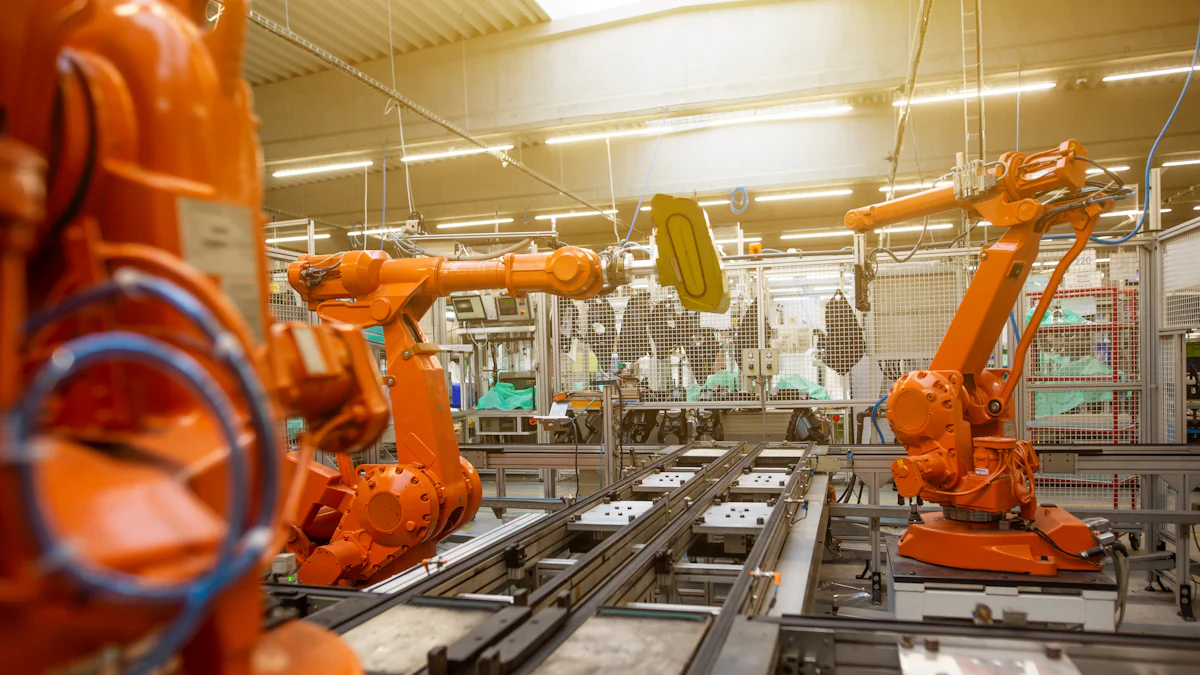Analyzing Digital Transformation in Manufacturing Supply Chains

Digital Transformation revolutionizes manufacturing supply chains by integrating advanced technologies. This transformation enhances efficiency, visibility, and collaboration across all stages, from demand planning to order fulfillment. A survey reveals that 67% of manufacturers accelerated digital projects post-COVID-19. Another survey indicates that 44% of manufacturers in advanced digital stages describe themselves as prospering. The need for higher-quality products drives 45% of respondents towards Digital Transformation. These advancements create agile, high-performance supply chains, enabling quicker responses to market demands.
Setting the Context
Historical Perspective
Traditional Manufacturing Supply Chains
Traditional manufacturing supply chains relied heavily on manual processes. Paper-based systems tracked inventory and managed orders. Communication between suppliers and manufacturers often faced delays. This lack of real-time information led to inefficiencies. Manufacturers struggled with long lead times and high operational costs.
Early Digital Initiatives
Early digital initiatives began with the adoption of basic technologies. Electronic Data Interchange (EDI) replaced paper documents. EDI enabled faster communication between supply chain partners. Manufacturers also started using Enterprise Resource Planning (ERP) systems. ERP systems integrated various business processes, improving data accuracy. These early steps laid the groundwork for more advanced Digital Transformation.
Current Landscape
Key Technologies Driving Transformation
Several key technologies drive the current wave of Digital Transformation. The Internet of Things (IoT) connects devices across the supply chain. IoT sensors collect real-time data on inventory levels and equipment status. Artificial Intelligence (AI) analyzes this data to optimize operations. Machine Learning (ML) algorithms predict demand and identify potential disruptions. Blockchain technology ensures transparency and traceability in transactions.
Industry 4.0 and Its Impact
Industry 4.0 represents the fourth industrial revolution. This era focuses on the integration of digital technologies into manufacturing. Smart factories use IoT, AI, and robotics to automate processes. Real-time data analytics enhance decision-making capabilities. Industry 4.0 enables manufacturers to create flexible and responsive supply chains. This transformation enhances efficiency and optimizes the entire supply chain ecosystem.
Digital Transformation in Action

Case Studies
Successful Implementations
Siemens implemented Digital Transformation in its manufacturing supply chain. Siemens integrated IoT and AI technologies to monitor equipment and predict maintenance needs. This integration reduced downtime by 20% and improved overall efficiency. Siemens also utilized real-time data analytics to optimize production schedules. This optimization resulted in a 15% increase in productivity.
General Electric (GE) adopted Digital Transformation to enhance its supply chain operations. GE used machine learning algorithms to forecast demand accurately. This forecasting minimized inventory costs and reduced waste. GE also employed blockchain technology to ensure transparency and traceability. This technology improved supplier collaboration and reduced fraud risks.
Lessons Learned
Successful Digital Transformation requires a strategic approach. Companies must set clear objectives aligned with business goals. Siemens and GE both emphasized the importance of real-time data analytics. Real-time data enables informed decision-making and enhances operational efficiency. Collaboration among stakeholders is crucial for seamless implementation. Both companies highlighted the need for continuous improvement and adaptation.
Technology in Action
IoT in Supply Chains
The Internet of Things (IoT) revolutionizes manufacturing supply chains. IoT sensors collect real-time data on inventory levels and equipment status. This data provides valuable insights into supply chain operations. Companies can monitor and manage resources more effectively. IoT enables predictive maintenance, reducing downtime and extending equipment life. Real-time tracking of shipments enhances visibility and ensures timely deliveries.
AI and Machine Learning Applications
Artificial Intelligence (AI) and Machine Learning (ML) play pivotal roles in Digital Transformation. AI analyzes vast amounts of data to optimize supply chain processes. ML algorithms predict demand patterns and identify potential disruptions. These technologies enable proactive decision-making and improve responsiveness. AI-powered automation streamlines repetitive tasks, increasing operational efficiency. Companies can achieve significant cost savings and enhance overall performance.
Benefits of Digital Transformation

Operational Efficiency
Cost Reduction
Digital Transformation significantly reduces costs in manufacturing supply chains. Companies that aggressively digitize their supply chains can expect a 50% reduction in process costs. This reduction comes from automating manual tasks and optimizing resource use. Manufacturers can pass these savings to customers, enhancing competitiveness. A McKinsey study shows that digitization boosts annual growth of earnings before interest and taxes by 3.2%. This financial benefit underscores the importance of Digital Transformation for cost management.
Improved Productivity
Improved productivity is another key benefit of Digital Transformation. Automation streamlines repetitive tasks, allowing employees to focus on higher-value activities. Real-time data analytics enable better resource allocation, reducing downtime. For instance, predictive maintenance minimizes equipment failures, ensuring continuous production. These improvements lead to a 20% increase in revenue, according to the MIT Center for Transportation and Logistics. Enhanced productivity helps manufacturers meet market demands more efficiently.
Enhanced Decision-Making
Real-time Data Analytics
Real-time data analytics play a crucial role in enhancing decision-making. IoT sensors and AI technologies collect and analyze vast amounts of data. This analysis provides insights into inventory levels, equipment status, and market trends. Manufacturers can make informed decisions quickly, improving responsiveness. A survey reveals that 66% of organizations prioritize Digital Transformation for its data-driven benefits. Real-time analytics help companies stay competitive in a fast-paced market.
Predictive Maintenance
Predictive maintenance is a game-changer for manufacturing supply chains. AI and Machine Learning algorithms predict equipment failures before they occur. This proactive approach reduces downtime and extends equipment life. Manufacturers can schedule maintenance during non-peak hours, minimizing disruptions. Predictive maintenance also lowers repair costs, contributing to overall cost reduction. Companies that implement Digital Transformation see significant improvements in operational efficiency and decision-making capabilities.
Practical Tips for Implementation
Strategic Planning
Setting Clear Objectives
Setting clear objectives forms the foundation of any successful digital transformation. Companies must define specific goals that align with their overall business strategy. For instance, a manufacturer might aim to reduce lead times by 20% or improve inventory accuracy by 15%. Clear objectives provide direction and help measure progress. According to Oracle, a well-defined vision tied to organizational goals is essential for effective digital transformation.
Aligning with Business Goals
Aligning digital transformation efforts with business goals ensures that technology investments deliver value. Companies should assess their existing resources, including employees, machinery, and data collection methods. This assessment helps identify gaps and areas for improvement. PTC emphasizes the importance of executive and employee buy-in. Both levels need to feel a sense of ownership over the project. Balancing decisions between the executive and functional levels enhances alignment with business goals.
Technology Adoption
Choosing the Right Tools
Choosing the right tools is crucial for a successful digital transformation. Companies must evaluate various technologies to determine which best meet their needs. IoT devices, AI algorithms, and cloud computing platforms are popular choices. Dr. Nadja Hatzijordanou highlights the importance of technologies like cloud and edge computing. These tools handle large data volumes and enable real-time analytics. Proper tool selection ensures seamless integration and supports advanced processing techniques.
Training and Development
Training and development play a vital role in technology adoption. Employees need to understand how to use new tools effectively. Comprehensive training programs should cover both technical skills and practical applications. PTC data shows that successful digital transformations require employee buy-in at all levels. Training fosters a sense of project ownership and boosts confidence in using new technologies. Continuous development programs keep employees updated on the latest advancements, ensuring long-term success.
Future Outlook and Challenges
Emerging Trends
Advanced Robotics
Advanced robotics will play a pivotal role in the future of manufacturing supply chains. Robots equipped with artificial intelligence (AI) can perform complex tasks with high precision. These robots will handle repetitive and hazardous tasks, reducing human error and improving safety. The integration of advanced robotics will streamline production processes and enhance operational efficiency. Companies adopting robotics will see significant improvements in productivity and cost savings.
Blockchain in Supply Chains
Blockchain technology will revolutionize supply chain management. This technology provides a decentralized and transparent ledger for recording transactions. Blockchain ensures traceability and authenticity of products, reducing fraud risks. Manufacturers can track the entire lifecycle of a product, from raw materials to final delivery. This transparency enhances trust among stakeholders and improves collaboration. Blockchain will also streamline compliance with regulatory requirements.
Potential Challenges
Cybersecurity Risks
Cybersecurity risks pose a significant challenge to Digital Transformation. The increased connectivity of devices and systems creates vulnerabilities. Cyberattacks can disrupt operations, leading to financial losses and reputational damage. Companies must invest in robust cybersecurity measures to protect their digital infrastructure. Regular security audits and employee training are essential to mitigate risks. A proactive approach to cybersecurity will safeguard the benefits of Digital Transformation.
Resistance to Change
Resistance to change is another major obstacle in Digital Transformation. Employees may fear job displacement due to automation and new technologies. Effective change management strategies are crucial to address these concerns. Companies should involve employees in the transformation process and provide adequate training. Clear communication about the benefits and goals of Digital Transformation will foster acceptance. Overcoming resistance will ensure a smooth transition and successful implementation.
Actionable Steps
Getting Started
Initial Assessments
Companies must begin Digital Transformation with thorough initial assessments. Evaluating current processes and technologies identifies gaps and opportunities. This step ensures a clear understanding of the existing supply chain landscape. Companies should analyze data quality and availability. High-quality data forms the foundation for effective transformation. Dr. Nadja H. emphasizes the importance of data as a strategic asset. Accurate data enables informed decision-making and optimization.
Pilot Projects
Pilot projects serve as a practical starting point for Digital Transformation. These small-scale initiatives test new technologies and processes. Companies can assess the impact without significant risk. Pilot projects provide valuable insights into potential challenges and benefits. Successful pilots build confidence and support for broader implementation. Real-time data from pilot projects helps refine strategies and tools. This approach ensures a smooth transition to full-scale transformation.
Scaling Up
Continuous Improvement
Continuous improvement is crucial for sustaining Digital Transformation. Companies must regularly review and refine their processes. Data-driven strategies enable ongoing optimization. AI and IIoT tools turn data into actionable insights. These insights help cut costs, boost efficiency, and optimize performance. Regular feedback loops ensure that improvements align with business goals. Continuous improvement fosters a culture of innovation and adaptability.
Long-term Strategy
A long-term strategy ensures the sustainability of Digital Transformation. Companies need a clear vision and roadmap for future developments. This strategy should align with overall business objectives. Long-term planning includes investing in advanced technologies and training. Companies must stay updated on emerging trends and innovations. A robust strategy ensures that Digital Transformation delivers lasting value. This approach positions companies for continued success in a dynamic market.
Digital Transformation revolutionizes manufacturing supply chains. Advanced technologies enhance efficiency, visibility, and collaboration. Real-time data analytics improve decision-making. Predictive maintenance reduces downtime and extends equipment life. Companies like Siemens and GE demonstrate successful implementations.
Dr. Nadja Hatzijordanou emphasizes the critical role of Digital Transformation in the manufacturing industry. This transformation drives operational efficiency and competitiveness.
Manufacturers must embrace Digital Transformation. Start with strategic planning and pilot projects. Invest in continuous improvement and long-term strategies. The future of manufacturing depends on this evolution.
See Also
Virtual Replicas: The Next Era in Supply Chain Management
Investigating Automation: Supply Chain Transformation
Efficiency Enhancements for High-Tech Manufacturing's Supply Chain Challenges
Guiding Transformation: Embracing Technology in Supply Chain Solutions
Will Virtual Replicas Shape the Future of Supply Chain Efficiency?
